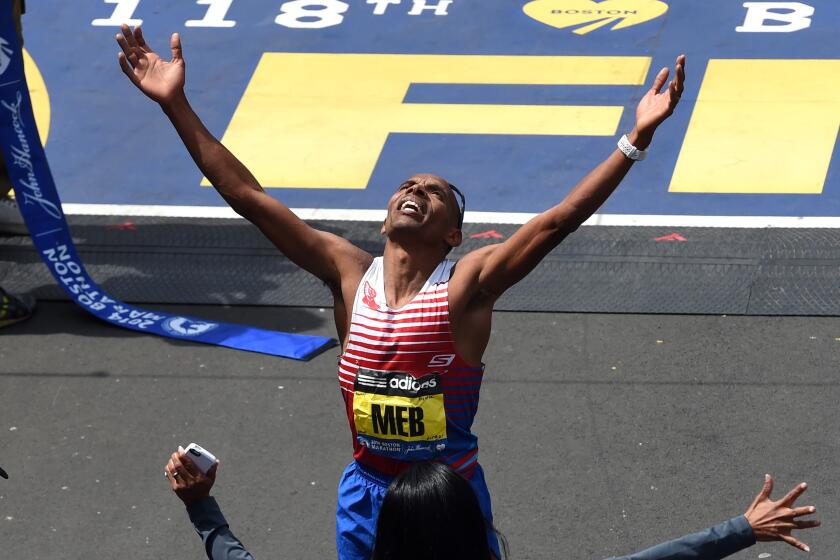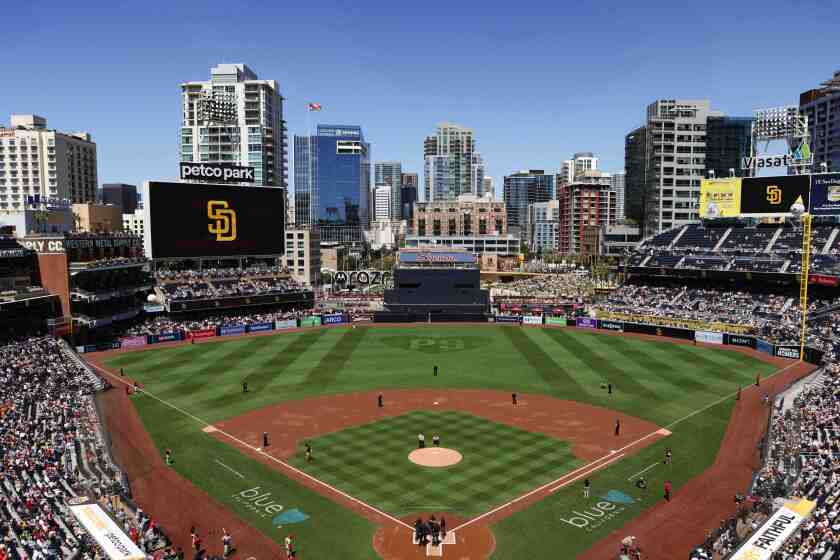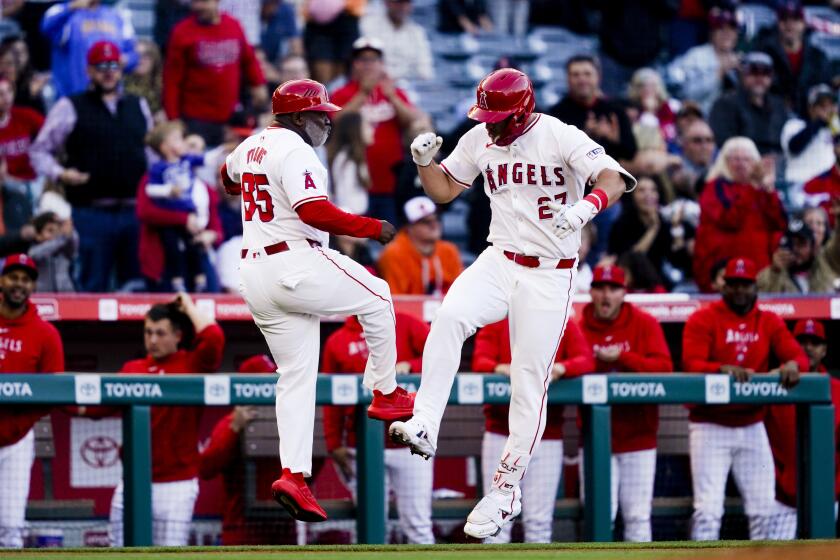Column: Patience, persistence allowed Del Mar to crack exclusive Breeders’ Cup club

The reasons Del Mar racetrack landed the Breeders’ Cup — a $28 million, nationally-televised, four-legged magnet for private jets, sheiks and cash from Ireland to Hong Kong — are rooted in expanded thinking as much as salesmanship.
The track that opened in 1937 always has owned singular ocean-side views. The facility continually warmed visitors with its Mission-style architecture and Hollywood star power since pipe-smoking Bing Crosby welcomed the first guests through the turnstiles.
Yet it failed to snag a Breeders’ Cup, an event that debuted in 1984 alongside the movie “Footloose” and video-game staple Tetris.
In time, San Diego evolved. In time, so did the Breeders’ Cup.
The two-day, 13-race event set for Nov. 3-4, the most money-soaked weekend in horse racing, met Del Mar in the patient, persistent middle — a cocktail of evolving philosophies, facility upgrades, legislation and timing.
The finish line was worth the wait, no matter the length of the dusty, grass-stained road.
“It puts us in a different light, once you get a Breeders’ Cup,” said Joe Harper, Del Mar’s president and CEO.
Del Mar duels Rodeo Drive, Fifth Avenue
To understand how difficult elbowing into the Breeders’ Cup rotation had been: Only two places, Santa Anita and Louisville’s venerable Churchill Downs, hosted the event from 2008-14.
To understand how Del Mar crashed through: Some frame the cause-and-effect as the racetrack simply widening its turf course in 2014, a $5 million project the Breeders’ Cup required for its larger fields. In truth, it’s far more complex and layered.
A quarter of a century ago, the region unknowingly began to position itself for the Cup board’s move toward quality over quantity. High-end hotels and restaurants began to pop up along San Diego County’s central coastline — a move that now aligns with maximizing the experience for a more discriminating fan base.
Instead of focusing on selling as many tickets as possible at giants like Churchill Downs, which has drawn 170,000 for the Kentucky Derby and 80,000 for the Breeders’ Cup, or Santa Anita (118,484 over two days for last year’s Cup), a strategy of more robust ticket, food and beverage pricing allowed places like 2015 host Keeneland and Del Mar to be considered.
Breeders’ Cup CEO Craig Fravel said premium packages now account for 75 percent of the event’s total revenue. That’s fuel for the reasoning behind capping attendance at 37,500 a day to minimize lines at everything from bathrooms to betting windows.
When Del Mar officials walked into a Manhattan boardroom at Breeders’ Cup sponsor Lalique three years ago, Del Mar boss Harper audibled off script like an NFL quarterback recognizing a blitz.
“We had rehearsed a dog-and-pony act,” he said. “When I saw the audience, I changed. I realized a lot of people in that room had never been to Del Mar. It was time to tell them about the market in San Diego and what it’s like.
“I told them there are 30,000 hotel rooms with a 15-minute drive of Del Mar. And good ones. Hotels, not motels. I love Santa Anita, but it’s a long way from Rodeo Drive. Belmont Park is great, but it’s a long way from Fifth Avenue.”
To enhance the experience, Del Mar plans to double its food and beverage staffing from opening-day levels — to 1,200. The amount of pari-mutuel clerks also will nearly double from normal track maximums of 220, with about 85 percent of the extra workers coming in from out of state.
The goal is to ensure fans paying as much as $1,625 for individual two-day tickets, or suite packages that climb as high as an average of $2,000 per person, buzz more than bark.
A push for a unique takeaways also meshed with Del Mar’s $100-million reinvention of its two-sided grandstand in 1992. The upgrade allows unmatched views of the horses, from receiving barns to the paddock to the track, along with stunning Pacific Ocean backdrops.
All of it fits the direction the Breeders’ Cup would head, more than two decades later.
“There was always kind of a chicken-and-egg problem,” said Fravel, a former Del Mar president. “I would say, ‘Tell us you’re going to bring the Breeders’ Cup here’ and they would say, ‘Tell us you’re going to rebuild the turf course.’
“Aside from the turf course, there was also a philosophical issue. In the old days, the Breeders’ Cup focused on large crowds that raised some question marks about this place.
“We’ve matured over the years and the focus has been on providing a great experience. So crowding people into large facilities isn’t the rule any more. When the team came to New York to present, the advantages of San Diego and Del Mar as a destination was overwhelming.”
Another tangle bedeviled for years, as well.
Not-for-profit Del Mar, working through its California landlord known as the 22nd District Agricultural Association, previously was limited to seven weeks of racing each summer. When Hollywood Park closed in 2013, Gov. Jerry Brown signed Assembly Bill 1074 to divvy up those racing dates among other tracks.
The state nudged Del Mar to pick up fall races in an effort to maintain opportunities for the industry, which greased the wheel to fall in line with the Breeders’ Cup timetable.
“Until the racing calendar changed,” Fravel said, “the ability to conduct racing here in early November was both a legislative and regulatory challenge.”
Area prepares for ‘$360 bottle’ crowd
When Del Mar found its Breeders’ Cup footing, it cracked the door of an enormous payoff for the region.
How big remains to be seen.
Officials raised some eyebrows last year when they estimated the event could result in $100 million worth of economic impact across the county. That would dwarf the reported impact of the Breeders’ Cup to Los Angeles County in 2013 by 54 percent and be an estimated 88 percent more, for example, than Louisville in 2011.
Craig Dado, Del Mar’s track’s chief marketing officer, cautioned against specific predictions, but also stopped short of backing away from the potential windfall.
The most recent ticket-sales data indicates 76 percent of Del Mar ticket buyers live outside of Southern California. That translates to more hotel nights, more restaurant visits and more sight-seeing.
“That’s a bigger number than I expected,” Dado said. “Most of the time, Breeders’ Cup fans come in on a Thursday and just stay the weekend. We’re hearing anecdotally from hotels that people are staying for big chunks of the week.”
Del Mar also is re-imagining the Breeders’ Cup feel and timeline.
A flood of events will stretch offerings across the entire week, ranging from Art of the Horse exhibits to a Barn at the Beach site in Powerhouse Park. Stops at places as varied as Birch Aquarium and Belly Up, the iconic Solana Beach music venue hosting Bret Michaels and the B-52s, also are scheduled.
Additional on-site touches include a pair of premium seating chalets erected at a cost of $720,000 and 400 tons of sand and truckloads of Adirondack chairs being hauled in to create a make-shift beach in the track’s infield.
Dave Tingle, general manager of the Brigantine Seafood & Oyster Bar overlooking Del Mar, said his business is excitedly bracing for the cash register-rattling unknown.
The restaurant will ramp up staffing by 15 to 20, triple its weekly alcohol order and stock up on high-end wines. One example: A case (six bottles) of the wallet-denting red wine Opus One, which has lasted the business a year, will be supplemented with 12 more of the $360 bottles.
“Our eyes are wide open,” Tingle said. “We’re going to treat the Breeders’ Cup like two (Del Mar) opening days, consecutively.”
Breeders’ Cup will deliver a different customer than other large sporting events like the 2008 U.S. Open, said Bob Harter, sales and marketing director of L’Auberge Del Mar.
The event created added incentive for the luxury boutique hotel to undertake a $4 million renovation that finished in January.
“I was at La Costa (Resort & Spa) during the Open and a lot of that was regional business,” he said. “People drove in for the tournament and drove back home. Breeders’ Cup is bringing in this international traveler to the destination. That elevates the audience with a truly affluent group. I’m not sure the U.S. Open did that.
“We were definitely motivated to push the renovation along. This is an amazing opportunity.”
Finally, San Diego saddles up.
Sports Videos
Go deeper inside the Padres
Get our free Padres Daily newsletter, free to your inbox every day of the season.
You may occasionally receive promotional content from the San Diego Union-Tribune.












